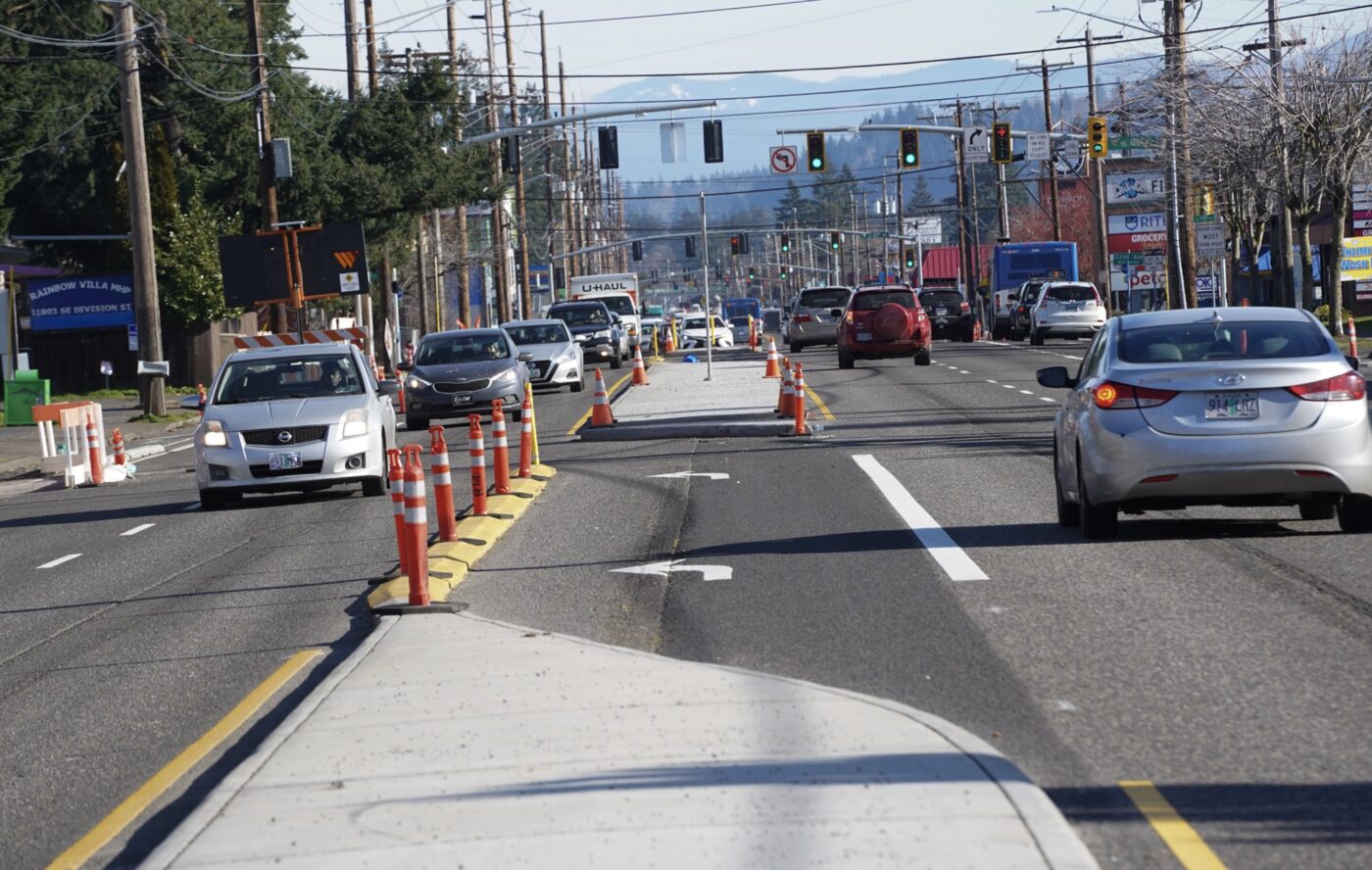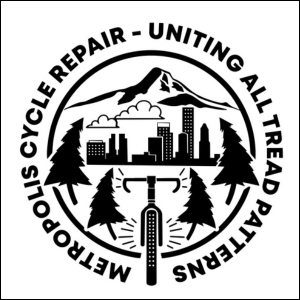
With a protest against the center medians on Southeast Division planned for this Thursday, you might be curious what Portland Bureau of Transportation and Commissioner Mingus Mapps think about them. Fortunately, we don’t have to wonder, because just last month the agency was at City Council to make the case for adding even more center medians to this major east Portland arterial.
Most of the center medians on Division were completed one year ago as part of PBOT’s $11 million Outer Division Safety Project. That project (which was related but separate from TriMet’s $175 million Division Transit project) looked to tame auto traffic and reduce fatal and serious injury crashes for all road users. One of its key components was an almost continuous, center-running median between 80th and 148th avenues. PBOT calls this “access management” because the medians manage where drivers can access various destinations.
But to some folks, the medians are confusing and inconvenient and an illustration of everything that’s wrong with Portland government. They’ve spent months complaining about the medians, speaking to the media and voicing objections in City Council testimony. The protest on Thursday will be the climax of an impressive campaign that has included door-hangers, yard signs, signs on business windows up and down the corridor, and so on.
So when PBOT returned to council last month to accept a $2.4 million state grant to install the final two segments of the medians, it was an opportunity for Commissioner Mapps, PBOT staff, and other council members to let us know where they stand on what Mapps referred to as “some controversy.”
Let’s take each of the opposition’s main concerns — driver safety/inconvenience, loss of business, first responder access — and see where PBOT stands on it.
Commissioner Mapps introduced the ordinance by making the case for safety. “Here’s why this ordinance is important,” he started out. “In the last 12 years there have been eight traffic fatalities on Division in this project area, and in the last 12 years, these blocks have seen about 17 traffic crashes which have resulted in injuries.”
To underscore the urgent safety problems on Division, PBOT enlisted its chief traffic engineer, Wendy Cawley, to testify. She wasn’t messing around. It sounded to me like she spoke with force because she felt like she had to defend the project.
“When we applied for this grant, we looked at five years of crash data,” Cawley shared with Mapps, Mayor Wheeler, and the rest of council. “And what we saw on on this particular section of Division was that there were 16 fatal and serious injury crashes, 109 moderate and minor injury crashes, and 60 property damage crashes.”
“In 2016 alone,” Cawley continued, “five people died in traffic crashes on outer Division. With the installation of a raised concrete median we expect to reduce all crash types by 47%. Which means that we could expect a reduction or 91 fewer crashes and seven fewer fatal and serious injury crashes.”
By contrast, the people opposing the medians on Division have shared videos of a few drivers who’ve crashed on the bike lane curbs because they didn’t see them and/or were going to fast to avoid them (video above). They’ve also complained about how hard it is to make u-turns.
On September 2nd, someone posted to the Division Street Activists Facebook group asking members to share any fatalities or crashes on Division since the medians went in (there’s also a photo on that page of a man holding a sign that reads, “PBOT U Turns Kills”). So far, no has responded with evidence of either. As far as I can tell, there’ve been no fatal or serious injury crashes caused by the medians.
Some of the folks who oppose the medians claim businesses have lost customers. That could be true. Some people might get frustrated by having to drive several extra blocks and just give up on reaching their destination.
On the flip side however, PBOT’s Cawley says, given their data and research, they expect the reduction in crashes, deaths and injuries due to the medians (and other safety components of the project, which included a bus lane, a protected bike lane, and a lower speed limit) will save the community an estimated $25 million in economic impacts (based on the FHWA’s estimate that puts the cost of a lost life at $5-6 million).
“So not only will this project save lives and heartache for many families impacted by traffic violence on Division, it’ll reduce economic impacts from traffic crashes in east Portland,” Cawley said at the end of her testimony.
Based on what I heard at council last month, it appears PBOT is unwavering in their support of medians because they wholeheartedly believe the treatment will reduce crashes and save lives.
Another point of contention from folks who don’t like the medians is that they feel PBOT didn’t listen to their feedback. They might have a point. PBOT staff defended their robust public outreach process during the initial go-round of changes on Division. But at council last month, they acknowledged they could have done better, and have committed to doing things differently this time.
PBOT Division Project Manager Elizabeth Tillstrom was asked about community feedback concerns by Commissioner Rene Gonzalez. After explaining their public process, she said, “But we didn’t always hear back from from folks that were ultimately being impacted. And so I think this time around, we’re going to be especially sensitive, and make sure that we’re having those conversations with businesses and property owners… So not taking a lack of response from businesses as being supportive of the design.”
Tillstrom also said that they made adjustments to the median design at the very last minute (during construction) when they realized some businesses had freight needs PBOT didn’t account for.
It was clear that Commissioner Mapps is aware of the concerns about the median. He made a point to jump into the conversation to allay concerns about the lack of communication between PBOT and some business owners and residents. He called on everyone to do better.
“I do believe that if we work together, listen to each other, increase the trust that’s at the table — which frankly I think is some of the work that we need to do here — we can bring this project to fruition, which will dramatically reduce deaths on one of our busiest streets in the city,” Mapps said.
Then Commissioner Gonzalez, who’s in charge of the Portland Fire Bureau, peppered the PBOT project manager with questions about emergency response times. Tillstrom was ready.
“We engaged extensively with police and fire during the design,” she reassured Gonzalez. “So the final design is we have constructed mountable medians for emergency response.” Tillstrom said PBOT staff went so far as to ride in a fire truck to test out the configuration and make sure it worked.
After hammering out all those issues, Commissioner Mapps shared one final comment before council voted in support of the ordinance. “I have gone out to this neighborhood and met with folks who are affected both by previous safety improvements and who are potentially impacted by future safety improvements that we want to fund with this ordinance before us today,” he said.
Then Mapps mentioned the Roman Russian Market specifically. That’s the business owned by one of the most active critics of the median, Fatima Magomadova (who I quoted at length in my story earlier this month). “We are in dialogue with folks, especially at the Russian market,” Mapps said. “Trading ideas back-and-forth about how we can introduce some modifications in this space that makes sense for everybody while also supporting safety. These conversations are really are challenging, but we are in dialogue and we’re looking for solutions and will continue to approach this project and this work in that spirit.”
There’s a lot riding on this for Mapps, who hopes to Portland’s next mayor. He’s toeing the line between respecting the strong criticisms aimed at his bureau, while also defending his bureau’s values, principles and work product.



